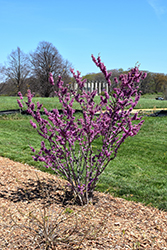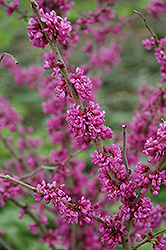It's all about ...
plants

Celestial Plum Redbud
Cercis yunnanensis 'Celestial Plum'
Height: 15 feet
Spread: 12 feet
Sunlight:
![]()
![]()
Hardiness Zone: 6b
Other Names: Yunnan Redbud
Description:
A brilliant spring bloomer that features wonderfully attractive plum-purple flowers held tightly on the bare branches in early spring, heart-shaped leaves; an ideal smaller ornamental tree for use in the garden or as a specimen in the home landscape
Ornamental Features
Celestial Plum Redbud has plum purple pea-like flowers along the branches from early to mid spring, which emerge from distinctive rose flower buds before the leaves. It has forest green deciduous foliage which emerges burgundy in spring. The heart-shaped leaves turn buttery yellow in fall.
Landscape Attributes
Celestial Plum Redbud is a multi-stemmed deciduous tree with an upright spreading habit of growth. Its relatively coarse texture can be used to stand it apart from other landscape plants with finer foliage.
This is a relatively low maintenance tree, and should only be pruned after flowering to avoid removing any of the current season's flowers. Deer don't particularly care for this plant and will usually leave it alone in favor of tastier treats. Gardeners should be aware of the following characteristic(s) that may warrant special consideration;
- Disease
Celestial Plum Redbud is recommended for the following landscape applications;
- Accent
- Mass Planting
- General Garden Use
Planting & Growing
Celestial Plum Redbud will grow to be about 15 feet tall at maturity, with a spread of 12 feet. It has a low canopy with a typical clearance of 2 feet from the ground, and is suitable for planting under power lines. It grows at a medium rate, and under ideal conditions can be expected to live for 50 years or more.
This tree does best in full sun to partial shade. It prefers to grow in average to moist conditions, and shouldn't be allowed to dry out. It is not particular as to soil type or pH. It is highly tolerant of urban pollution and will even thrive in inner city environments, and will benefit from being planted in a relatively sheltered location. Consider applying a thick mulch around the root zone in winter to protect it in exposed locations or colder microclimates. This is a selected variety of a species not originally from North America.
This plant is not reliably hardy in our region, and certain restrictions may apply; contact the store for more information.

